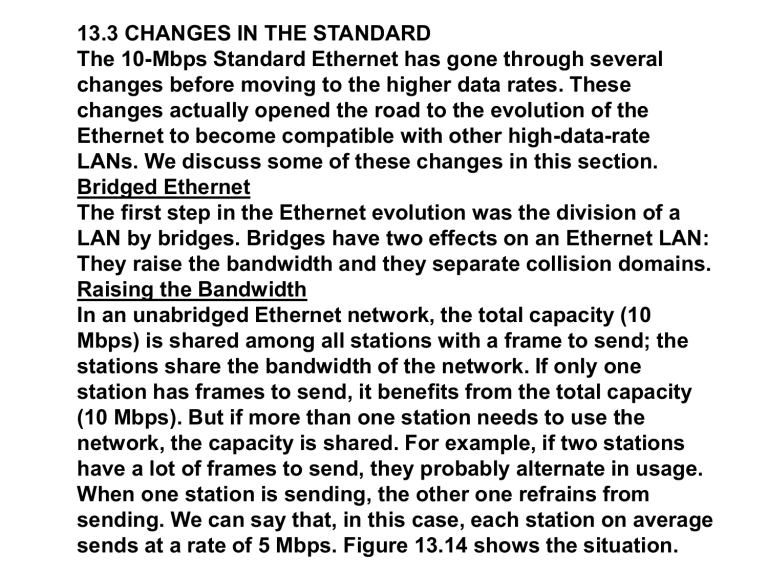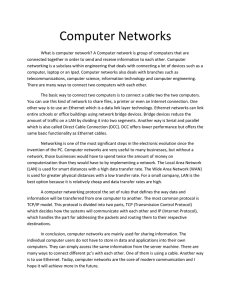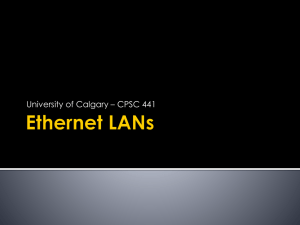Lec_14

13.3 CHANGES IN THE STANDARD
The 10-Mbps Standard Ethernet has gone through several changes before moving to the higher data rates. These changes actually opened the road to the evolution of the
Ethernet to become compatible with other high-data-rate
LANs. We discuss some of these changes in this section.
Bridged Ethernet
The first step in the Ethernet evolution was the division of a
LAN by bridges. Bridges have two effects on an Ethernet LAN:
They raise the bandwidth and they separate collision domains.
Raising the Bandwidth
In an unabridged Ethernet network, the total capacity (10
Mbps) is shared among all stations with a frame to send; the stations share the bandwidth of the network. If only one station has frames to send, it benefits from the total capacity
(10 Mbps). But if more than one station needs to use the network, the capacity is shared. For example, if two stations have a lot of frames to send, they probably alternate in usage.
When one station is sending, the other one refrains from sending. We can say that, in this case, each station on average sends at a rate of 5 Mbps. Figure 13.14 shows the situation.
The bridge, as we will learn in Chapter 15, can help here. A bridge divides the network into two or more networks. Bandwidth-wise, each network is independent. For example, in Figure 13.15, a network with 12 stations is divided into two networks, each with 6 stations. Now each network has a capacity of 10 Mbps. The l0-
Mbps capacity in each segment is now shared between 6 stations
(actually 7 because the bridge acts as a station in each segment), not 12 stations. In a network with a heavy load, each station theoretically is offered 10/6 Mbps instead of 10/12 Mbps, assuming that the traffic is not going through the bridge.
It is obvious that if we further divide the network, we can gain more bandwidth for each segment. For example, if we use a fourport bridge, each station is now offered 10/3 Mbps, which is 4 times more than an unabridged network.
Separating Collision Domains
Another advantage of a bridge is the separation of the collision domain. Figure 13.16shows the collision domains for an unabridged and a bridged network. You can see that the collision domain becomes much smaller and the probability of collision is reduced tremendously. Without bridging, 12 stations contend for access to the medium; with bridging only 3 stations contend for access to the medium.
Switched Ethernet
The idea of a bridged LAN can be extended to a switched
LAN. Instead of having two to four networks, why not have N networks, where N is the number of stations on the LAN? In other words, if we can have a multiple-port bridge, why not have an N-port switch? In this way, the bandwidth is shared only between the station and the switch (5 Mbps each). In addition, the collision domain is divided into N domains. A layer 2 switch is an N-port bridge with additional
sophistication that allows faster handling of the packets.
Evolution from a bridged Ethernet to a switched Ethernet was a big step that opened the way to an even faster
Ethernet, as we will see. Figure 13.17
shows a switched LAN.
Full-Duplex Ethernet
One of the limitations of 10Base5 and l0Base2 is that communication is half-duplex (l0Base-T is always full-duplex); a station can either send or receive, but may not do both at the same time. The next step in the evolution was to move from switched Ethernet to full-duplex switched Ethernet. The fullduplex mode increases the capacity of each domain from 10 to
20 Mbps. Figure 13.18 shows a switched Ethernet in full-duplex mode. Note that instead of using one link between the station and the switch, the configuration uses two links: one to transmit and one to receive.
No Need for CSMA/CD
In full-duplex switched Ethernet, there is no need for the
CSMA/CD method. In a full duplex switched Ethernet, each station is connected to the switch via two separate links.
Each station or switch can send and receive independently without worrying about collision. Each link is a point-to-point dedicated path between the station and the switch. There is no longer a need for carrier sensing; there is no longer a need for collision detection. The job of the MAC layer becomes much easier. The carrier sensing and collision detection functionalities of the MAC sub layer can be turned off.
MAC Control Layer
Standard Ethernet was designed as a connectionless protocol at the MAC sub layer. There is no explicit flow control or error control to inform the sender that the frame has arrived at the destination without error. When the receiver receives the frame, it does not send any positive or negative acknowledgment. To provide for flow and error control in full-duplex switched
Ethernet, a new sub layer, called the MAC control, is added between the LLC sub layer and the MAC sub layer.




